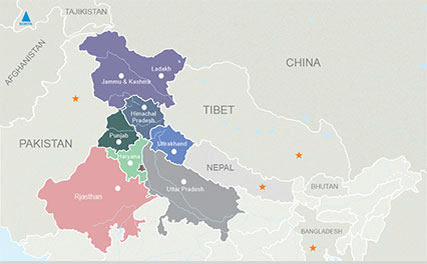
Kailash Manasarovar Aerial Darshan at Just @ Rs 35,000 Reserve Your Seat Now! Click Here
Allahbad is an amalgamation of religion, politics, and culture in Uttar Pradesh. It is also popular for Sangam – the confluence of three pious rivers Ganga, Yamuna, and Saraswati. Every year it attracts thousands of tourists and pilgrims. Allahbad is rich in heritage, has a unique history, and gives a glimpse of myriad culture.
The people are warm and hospitable which adds to the overall travel experience. You can seek blessings at various religious sites and make it a religious tour, or explore the historical monuments, museums, and bazaars in and around the city. There is a lot to do in this bustling city and you’ll surely take back great memories.

50,000
Mahaparinirvana Temple, Ramabhar Stupa, Kushinagar Museum
30°C to 40°C
27°C to 32°C
18°C to 26°C
The divine place Kushinagar is a crucial point in the Buddhist trail of India. It is the place where Lord Buddha had freed himself from the continuous cycles of life and death, i.e., Mahaparinirvana. Once the capital of Malla kingdom Kushinagar, is around 51 km from Gorakhpur in Uttar Pradesh, and is one prime Buddhist pilgrimage spot. This place also has its mention in the epic Ramayana. According to it, the Mallas Kingdom was earlier part of Kosala Janpad and Kushwati, the capital was made by Kush, the son of Lord Ram. The other school of thought, the Buddhist literature, says Kushinagar was named prior to the king Kush and the place had abundance of grass (Kush), which related to the nomenclature of this place. Kushinagar was an important part of the ancient dynasties of Kushana, Maurya, Harsha, Gupta and Shunga.
However, Kushinagar of the present day came into limelight with the 19th Century archeological excavations by the first Archeological Surveyor of India. The different phases of excavations brought innumerable relics out to the sunlight. A unique glimpse into history are the Buddhist Stupas in Kushinagar, which date back to 230 BC-AD 413. A 6.10 meters long statue of reclining Buddha was also excavated.
A Burmese Monk converted the "Mahaparinirvana Temple" into a living shrine 1903. The reclining statue of Buddha that is 20-feet-long and seated on a brick platform is here in the temple. The excavations here are segregated into Nirvana Temple, Central Stupa and Mathakuar Kot & Ramabhar Stupa. The worldwide famous Buddha Statue, which is carved out of a huge single piece of red sandstone is a workmanship to adore. History says, Ashoka - The Mauryan Emperor, who became an ardent follower of Buddhism, had built this statue. Popular monasteries here are Mahaparinirvana Vihara and Makutabandhara Vihara, which serve as centers for the practice of Buddhism. Tourists and Buddhist pilgrims across geographical boundaries visit this place, which is a prime part in the famous Buddhist circle encompassing Bihar, Uttar Pradesh, and Nepal.
When done with sightseeing here in Kushinagar, take out time and do visit the Wat Thai Kusinara, nearby. This new city in an area of 10 acres is developed by the Thai pilgrims and houses hundreds and hundreds of Buddhists from Thailand, who have come here to learn and practice the gospel of Buddha.
Put us on work to plan your next travel. Send your details to our experts now to get a free travel plan with quote